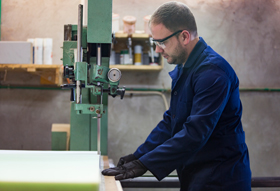
Polyurethane foam testing processes

Since its very first production run over 50 years ago, polyurethane foam has continued to undergo rigorous, high-quality testing procedures. Being an incredibly versatile material that can be manufactured to hold a diverse range of properties and characteristics, it is unsurprising that all forms of polyurethane product undergo a number of tests.
By undertaking thorough testing procedures, every characteristic and property of a foam material is accurately measured and recorded. This is important as it allows manufacturers to correctly allocate the foam product to its rightful application. For example, foam inserts used inside flight casings need to be measured by their quality of shock absorbency to ensure they withstand the demands of air freight travel.
In terms of the four most popular types of tests conducted, the most universal is the 'flex fatigue' test, designed to test the resilience of a foam product by calculating durability through repetitive compressions and actions. By using a dedicated testing machine, the material is pushed to its limits by undergoing thousands of compressions, from which the percentage of IFD (Indentation Force Deflection) loss is measured against the foam's original height. Depending on manufacturer preference, longer testing procedures tend to give a better overview of a foam's overall durability, whereas shorter, more standard tests can determine how much firmness and/or density will be lost through initial customer use. Either way, tests that fall under the category of 'flex fatigue' can assess a range of foam properties, with some industry machines able to undertake a range of different compression tests at once.

Second to 'flex fatigue' is hysteresis - a test undertaken by foam manufacturers to determine to what extent a foam will retain its original firmness properties. Conducted under laboratory conditions, a foam sample is indented by 25 percent before its firmness is measured. Then, the foam is indented to 65 percent and again re-measured, before the indentation is then released back to 25 percent - all without allowing the foam to fully expand again. This is the crucial part, because though the 25 percent indentation is maintained, the foam won't recover the full amount of its 25 percent firmness. In fact, the firmness it does manage to recover gives a solid indication of the material's overarching durability.
Two further tests - firmness and support factor - are crucial for assessing whether a foam material is suitable for supporting weight. Usually, foam of a higher density has a better support factor, although this can vary. Like hysteresis, foam is first compressed by 25 percent and is then compressed to 65 percent of its height by using a second IFD measurement. By noting the difference between the two IFD measurements, a greater variation means the foam has a higher ability to support weight. To calculate the foam's overall support factor, the ratio of the 65 percent IFD is divided by the 25 percent IFD. Likewise, the overall firmness of a foam can be measured using the force in pounds required to compress the foam sample to 25 percent of its original height.
There is an incredible array of tests used to assess different types of foam material - of which there are too many to explore in lengthy detail. However, from resilience and roller shear to air flow, all tests are used to diagnose a foam's most optimal performance. Stay tuned for our subsequent blogs which look to explore testing procedures in further detail.

